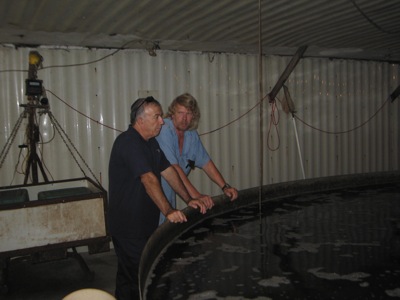Friday, August 11th, 2006
Celina seeks hefty water rate increase
By Timothy Cox
Celina city administration officials are seeking to raise water rates by more than 30 percent to maintain existing water plant operations.
Further rate increases could be implemented before the full 30 percent increase fully takes effect. The additional increases are necessary, they say, to pay for new facilities to be built to bring the city's water into compliance with Ohio EPA regulations.
City officials won't know how much water rates will be raised to pay for the new treatment facility until its design is finalized. City officials plan to build a granular activated carbon (GAC) treatment facility on the site of the Blue Goose and connect it to the city's existing treatment facilities directly to the south.
Celina City Council members will consider the first round of water rate increases on Monday, when they could modify the administration's plan or hand the issue off to a committee for further discussion.
The proposed ordinance calls for a 15 percent increase in current water rates beginning Oct. 1. Another 15 percent bump in water prices would take effect Jan. 1, 2008. The ordinance also calls for 3 percent annual inflationary increases in water rates for five years beginning Jan. 1, 2007.
Those proposed increases would help meet current costs and the cost of running the new GAC treatment, but not build the new facility. The carbon-based material that will be used to treat the city's water near the end of the existing process will need to be replaced periodically at an estimated cost of $330,000 annually.
Construction costs of the GAC facility were previously estimated at $1.5 million, but city officials will not know the exact expense until later this year when designs are finalized.
The city still does not have a firm under contract to do the design work, but officials are expected to hire Metcalf & Eddy, the same company that has guided the most recent studies of the city's water system.
Safety-Service Director Jeff Hazel said Thursday he hopes construction of the new facility can begin by next spring. That would put completion on a tight timeline to meet an Ohio EPA-mandated deadline of November 2007 to bring the city's water into compliance.
Testing has showed the GAC treatment will be effective in removing organic material that is present in the water drawn from Grand Lake.
The organic material reacts whith chlorine added to the water and eventually forms trihalomethanes (THM). The chemical compound has been linked to cancer and other diseases in laboratory tests and the city's THM levels routinely far exceed EPA limits.
The proposed rate increases would apply to all users uniformly. That means the 15 percent hikes and the inflationary increases would be the same for all customers, regardless of whether they are inside or outside of the city or whether they are large users, which are charged cheaper rates.
The city charges rural water customers in eastern Jefferson Township a 10 percent surcharge. Mercer County, which owns the rural water infrastructure, also charges those customers an additional 50 cents per 1,000 gallons of water used.
The 3 percent inflationary increase would not apply to the county's surcharge, as the rate ordinance is proposed.
Residential customers in the city now pay $6.57 per 1,000 gallons of water for the first 3,000 gallons and $4.55 per 1,000 gallons for additional usage up to 50,000 gallons. Large industrial customers pay the same rates but pay a reduced rate of $3.82 per 1,000 gallons for all water in excess of 50,000 gallons monthly.
Rural water customers pay base rates of $7.23 per 1,000 gallons and $5.01 per 1,000 gallons over 3,000 gallons. The industrial rate is $4.21 per 1,000 gallons after 50,000 gallons of usage for companies outside the city limits.
Based on the proposed increases, water rates rise about 36 percent by Jan. 1, 2008.
City officials plan to do a cost-of-service study that will determine the city's exact costs of producing and distributing water. More rate adjustments could be made after that point, Hazel said.
Reasons for price hike:
Celina city officials point to several factors needed for a significant increase in water revenue. They include:
• The anticipated $330,000 annual cost for a new treatment process being added to the water plant.
• Costs of chemicals and polymers used in the treatment process have risen 28 percent in three years.
• The water fund's reserve balance is $62,000. The annual cost of replacing old water lines now runs about $100,000.
• To accommodate the new treatment process, the water plant now runs 24 hours per day, seven days a week. Two new full-time employees were hired at a total cost of about $100,000, including wages and benefits.

